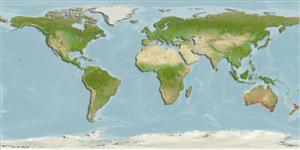Environment: milieu / climate zone / depth range / distribution range
Écologie
marin récifal; profondeur 1 - 70 m (Ref. 9563). Temperate
Indo-Pacific: Southern Australia from central New South Wales to a similar latitude in Western Australia.
Taille / Poids / Âge
Maturity: Lm ? range ? - ? cm
Max length : 40.0 cm TL mâle / non sexé; (Ref. 9563)
Found commonly in shallow bays. Nocturnal. Occurs in small aggregations.
Life cycle and mating behavior
Maturities | Reproduction | Spawnings | Egg(s) | Fecundities | Larves
Kuiter, R.H., 1993. Coastal fishes of south-eastern Australia. University of Hawaii Press. Honolulu, Hawaii. 437 p. (Ref. 9002)
Statut dans la liste rouge de l'IUCN (Ref. 130435)
Menace pour l'homme
Poisonous to eat
Utilisations par l'homme
Pêcheries: sans intérêt
Outils
Articles particuliers
Télécharger en XML
Sources Internet
Estimates based on models
Preferred temperature (Ref.
123201): 15.1 - 22.4, mean 17.8 °C (based on 198 cells).
Phylogenetic diversity index (Ref.
82804): PD
50 = 0.5313 [Uniqueness, from 0.5 = low to 2.0 = high].
Bayesian length-weight: a=0.04786 (0.01967 - 0.11644), b=2.82 (2.61 - 3.03), in cm total length, based on LWR estimates for this (Sub)family-body shape (Ref.
93245).
Niveau trophique (Ref.
69278): 3.8 ±0.2 se; based on size and trophs of closest relatives
Résilience (Ref.
120179): Milieu, temps minimum de doublement de population : 1,4 à 4,4 années (Preliminary K or Fecundity.).
Fishing Vulnerability (Ref.
59153): Low to moderate vulnerability (30 of 100).
Nutrients (Ref.
124155): Calcium = 12.6 [4.6, 33.8] mg/100g; Iron = 0.208 [0.097, 0.509] mg/100g; Protein = 18.7 [16.5, 20.9] %; Omega3 = 0.306 [0.149, 0.623] g/100g; Selenium = 9.16 [3.91, 21.99] μg/100g; VitaminA = 31 [7, 149] μg/100g; Zinc = 0.47 [0.30, 0.77] mg/100g (wet weight);
